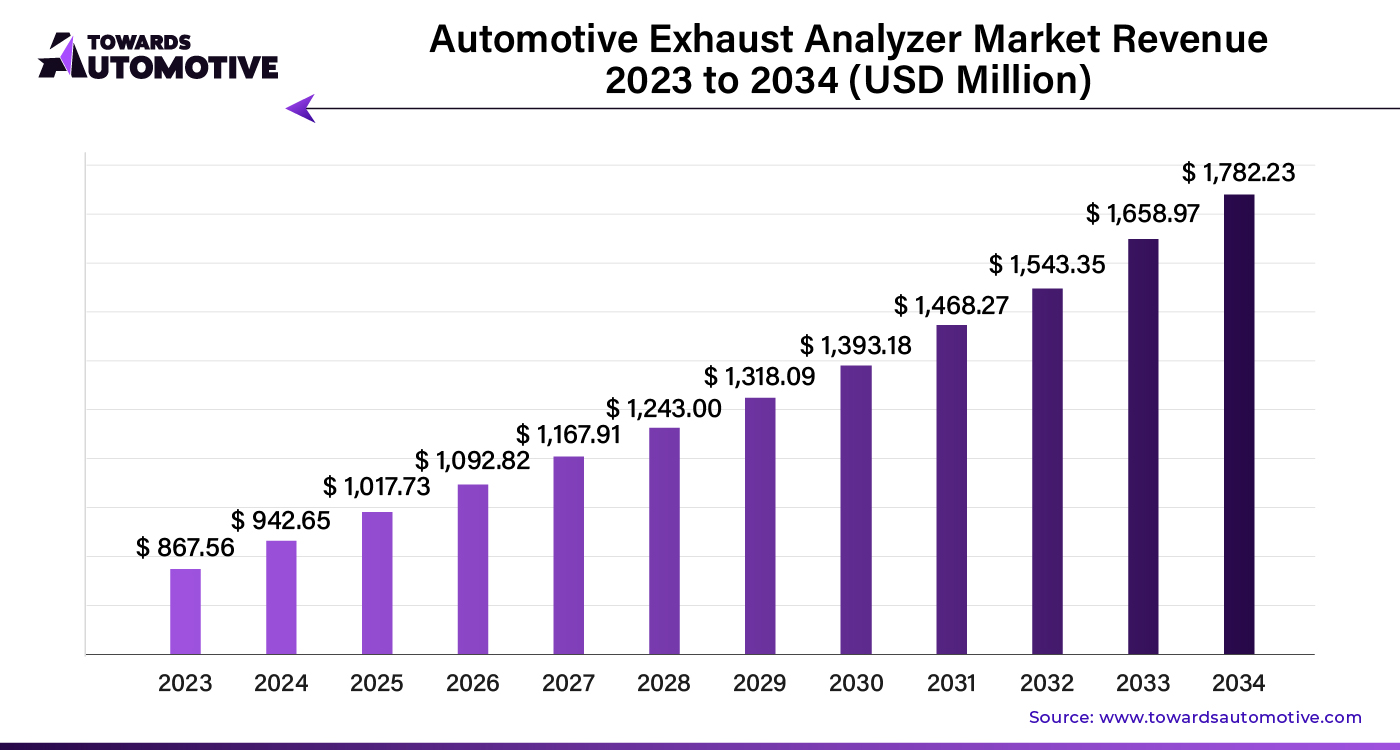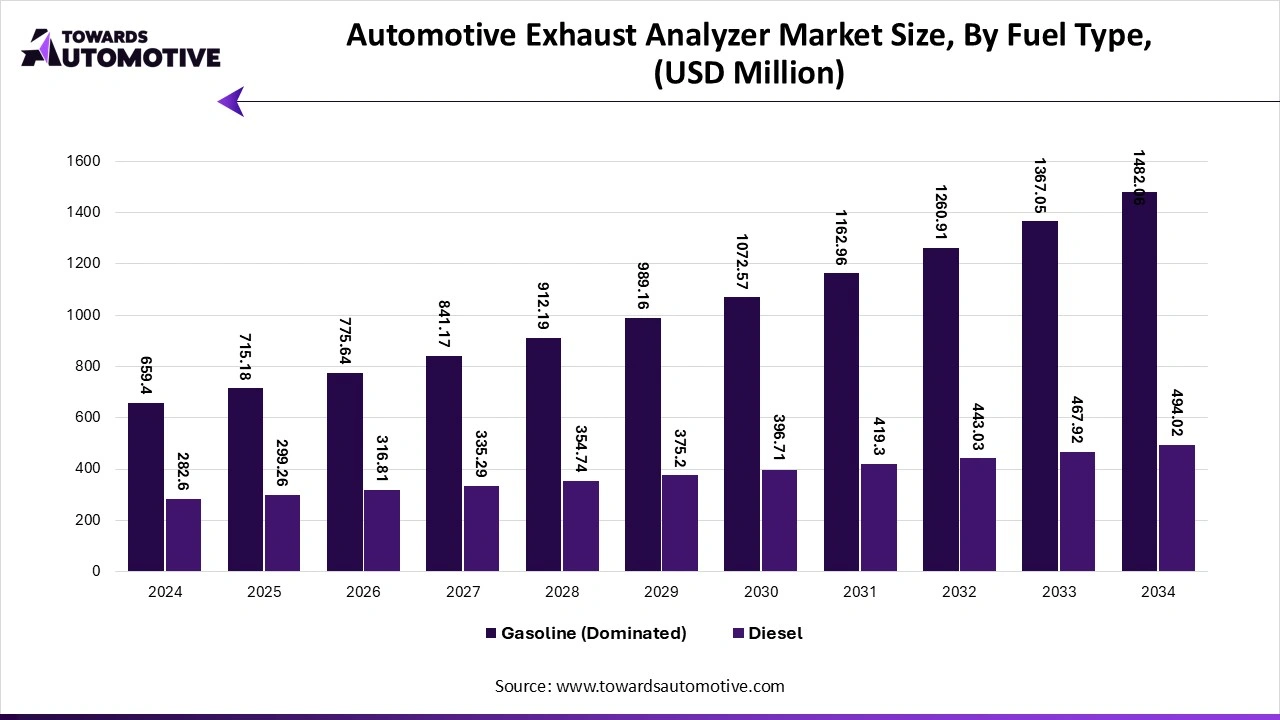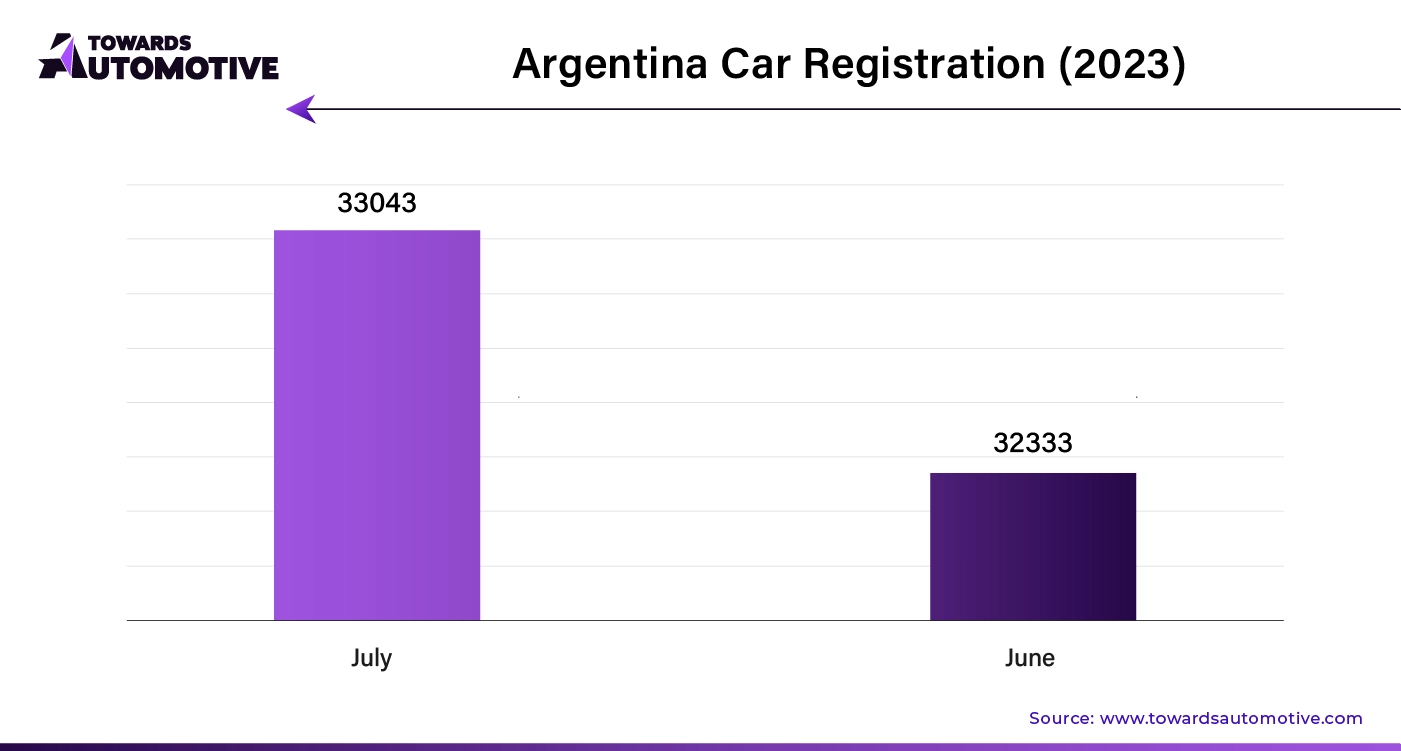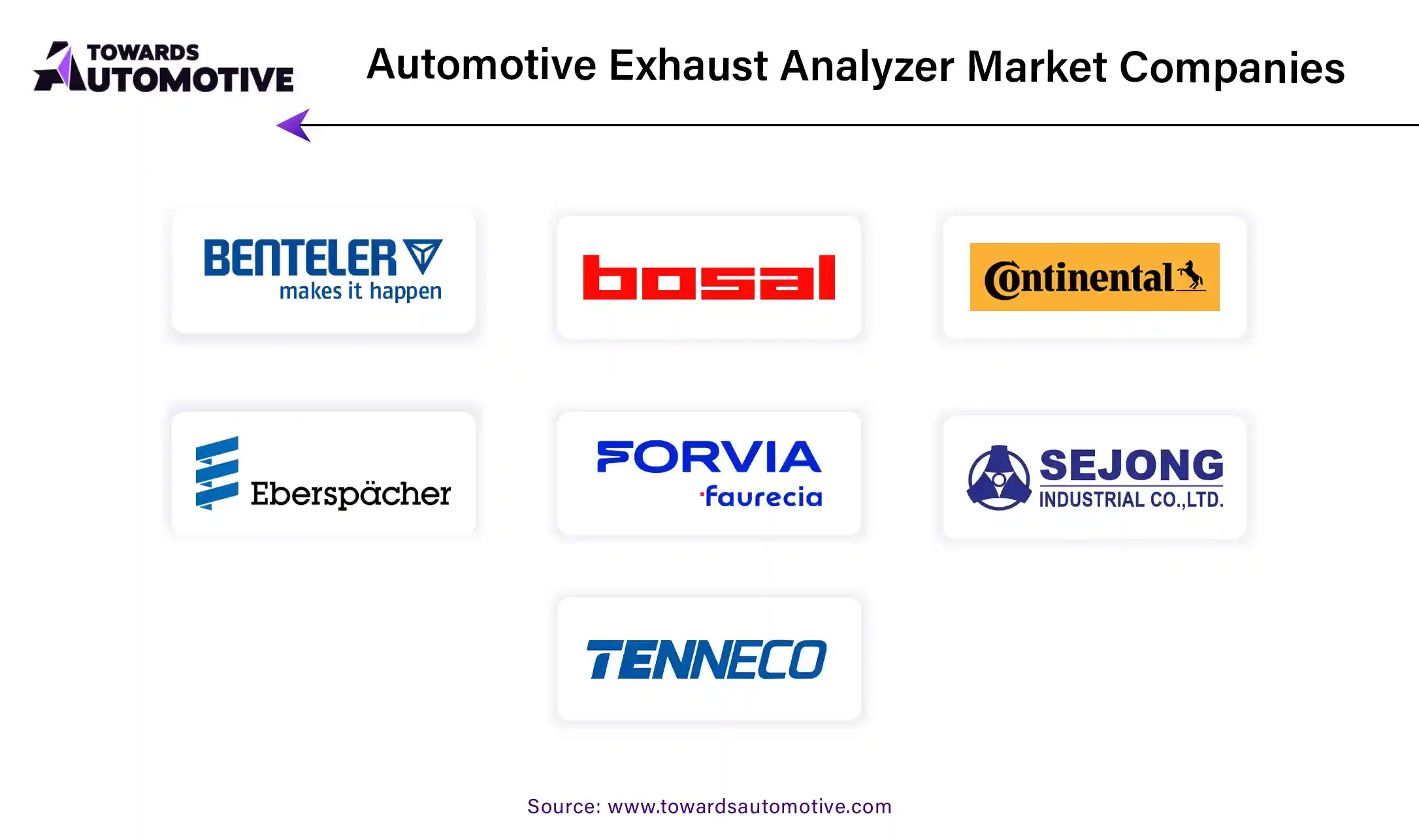October 2025
The automotive exhaust analyzer market is projected to expand from USD 1,017.73 million in 2025 to USD 1,782.23 million by 2034, registering a CAGR of 7.69%. This report provides a comprehensive overview of component, fuel type, vehicle type, and regional segmentation across North America, Europe, Asia Pacific, Latin America, and the Middle East & Africa. It includes detailed competitive benchmarking of top players such as BENTELER, BOSAL, Continental AG, FORVIA Faurecia, and Tenneco Inc., along with value chain and supply chain mapping, trade flow analysis, and manufacturer and supplier profitability metrics for 2024. The study further explores the technological and investment trends shaping innovation in emission control systems globally.

The automotive exhaust analyzer market is experiencing significant growth, driven by a combination of regulatory pressures, technological advancements, and shifting consumer preferences. As governments worldwide enforce stricter emissions regulations to combat air pollution and reduce greenhouse gas emissions, automakers are increasingly investing in advanced exhaust technologies that comply with these standards. This has led to the development of more efficient exhaust systems, including catalytic converters and particulate filters, designed to minimize harmful emissions while maximizing engine performance.
Technological innovations in exhaust systems are also contributing to market expansion. Manufacturers are integrating advanced materials, such as lightweight composites and stainless steel, which enhance durability and reduce weight, ultimately improving vehicle efficiency. Additionally, the rise of electric and hybrid vehicles is reshaping the exhaust systems landscape, as manufacturers seek to design systems that cater to these new powertrains. While electric vehicles typically require less complex exhaust systems, the growth of hybrids still necessitates sophisticated solutions to manage emissions effectively.
Consumer preferences are shifting towards vehicles with better fuel efficiency and lower emissions, further propelling the demand for advanced exhaust systems. As awareness of environmental issues grows, consumers are more inclined to choose vehicles equipped with technologies that align with their sustainability values. This trend is particularly pronounced in developed markets where eco-conscious driving is becoming the norm.
In summary, the Automotive exhaust analyzer Market is poised for continued growth due to the convergence of regulatory requirements, technological advancements, and evolving consumer preferences. As the automotive industry transitions toward more sustainable practices, exhaust systems will play a crucial role in enhancing vehicle performance and meeting stringent emissions standards.
AI is playing a transformative role in the Automotive exhaust analyzer Market by enhancing efficiency, performance, and compliance with emissions regulations. AI algorithms can analyze data from exhaust system sensors to predict potential failures or maintenance needs. By continuously monitoring the condition of components such as catalytic converters and particulate filters, AI can provide early warnings of issues, allowing for timely interventions and reducing the likelihood of costly repairs or vehicle downtime.
AI technologies enable real-time monitoring and adjustment of exhaust system parameters to optimize emissions performance. Machine learning models can analyze data from various sensors to ensure that the exhaust system operates within the most efficient range, helping to meet stringent emissions standards while improving fuel efficiency.
AI-driven design tools facilitate the development of more efficient exhaust systems. By simulating various operating conditions and exhaust system configurations, engineers can use AI to optimize designs for weight, durability, and performance. This leads to innovations in exhaust system technologies that enhance overall vehicle efficiency and reduce emissions.
AI can assist automakers in ensuring that their exhaust systems meet evolving emissions regulations. By analyzing data on vehicle performance and emissions in real-time, AI can help manufacturers stay compliant with governmental standards and avoid penalties associated with non-compliance.
AI can analyze market trends and consumer preferences, helping manufacturers understand the demand for specific exhaust system features. This information can inform product development, guiding investments in technologies that align with consumer expectations for sustainability and performance.
The rising demand for sports cars is a significant driver of growth in the Automotive exhaust analyzer Market, as enthusiasts and consumers increasingly seek vehicles that offer not only performance but also distinctive sound profiles and aesthetics. Sports cars are designed for high performance, requiring advanced exhaust systems that enhance engine efficiency, power output, and throttle response. As manufacturers strive to meet consumer expectations for speed and performance, they are investing in sophisticated exhaust technologies that optimize airflow and reduce backpressure, ultimately boosting engine performance.
Additionally, the popularity of high-performance vehicles is often accompanied by an emphasis on distinctive exhaust notes that enhance the driving experience. Car enthusiasts are particularly attentive to the sound produced by the exhaust system, and manufacturers are incorporating innovations such as adjustable exhaust valves and active exhaust systems that allow drivers to customize the sound according to their preferences. This trend not only caters to the emotional aspect of driving sports cars but also serves to distinguish brands in a competitive market.
Furthermore, as consumers become more environmentally conscious, the automotive industry is seeing a shift towards performance-oriented vehicles that also meet stringent emissions regulations. Sports car manufacturers are increasingly integrating advanced exhaust technologies, such as catalytic converters and particulate filters, to ensure compliance without compromising performance. This dual focus on performance and sustainability is driving the demand for innovative exhaust systems tailored to sports cars.
The automotive exhaust analyzer market faces several restraints that may hinder its growth. One significant challenge is the increasing adoption of electric vehicles (EVs), which have simplified exhaust systems or none at all, leading to reduced demand for traditional exhaust components. Additionally, stringent environmental regulations may impose high compliance costs on manufacturers, as they invest in advanced technologies to meet emissions standards. Furthermore, the rising cost of raw materials can impact production expenses, potentially leading to higher prices for consumers. Lastly, the ongoing shift toward sustainable transportation solutions may limit the market potential for conventional automotive exhaust analyzer in the long term.
Advancements in smart exhaust systems are creating significant opportunities in the Automotive exhaust analyzer Market, driven by the growing demand for enhanced vehicle performance, efficiency, and real-time monitoring capabilities. Smart exhaust systems integrate sophisticated sensors and AI technologies that enable continuous monitoring of emissions, temperature, and pressure within the exhaust system. This data allows for adaptive adjustments to optimize exhaust flow and reduce harmful emissions, ensuring compliance with stringent environmental regulations. Furthermore, these systems can provide valuable feedback to drivers, enhancing the overall driving experience by allowing them to customize exhaust sound profiles and performance characteristics.
The integration of smart technologies also supports predictive maintenance, enabling early detection of potential issues and reducing the risk of costly repairs. As consumers increasingly prioritize sustainability and performance, automakers are focusing on developing intelligent exhaust solutions that align with these preferences. Additionally, the rise of electric and hybrid vehicles further propels the need for innovative exhaust systems that can manage emissions effectively. Overall, advancements in smart exhaust systems present a wealth of opportunities for manufacturers to differentiate their products, improve vehicle efficiency, and cater to the evolving demands of environmentally conscious consumers, thereby driving growth in the Automotive exhaust analyzer Market.

The gasoline segment held the largest share of the market. The gasoline segment is a critical driver of growth in the automotive exhaust analyzer market, primarily due to the enduring popularity of gasoline-powered vehicles among consumers. Despite the rise of electric and hybrid vehicles, gasoline engines remain prevalent in various vehicle categories, including passenger cars, SUVs, and light trucks. As a result, the demand for advanced exhaust systems that can efficiently manage emissions and enhance performance continues to be robust.
Gasoline engines generate a range of pollutants, necessitating the implementation of sophisticated exhaust systems, including catalytic converters and particulate filters, to meet stringent emissions regulations. Automakers are increasingly investing in technologies that optimize exhaust flow and reduce backpressure, thereby improving engine efficiency and performance while minimizing harmful emissions. Furthermore, advancements in materials and design, such as lightweight alloys and modular systems, are enhancing the effectiveness and durability of gasoline exhaust components.
The ongoing development of high-performance gasoline engines, coupled with consumer preferences for sportier, more powerful vehicles, also fuels demand for specialized exhaust systems that provide distinctive sound profiles and improved throttle response. Overall, the gasoline segment plays a pivotal role in driving innovation and growth within the Automotive exhaust analyzer Market, as manufacturers adapt to meet regulatory demands and consumer expectations for performance and sustainability.
The passenger car segment led the industry. The passenger car segment is a significant driver of growth in the automotive exhaust analyzer market, largely due to the increasing demand for personal vehicles globally. As urbanization rises and disposable incomes improve, more consumers are opting for passenger cars, leading to a higher production volume and, consequently, a greater need for efficient exhaust systems. Passenger cars typically have diverse engine configurations, including gasoline, diesel, and hybrid powertrains, all of which require advanced exhaust systems to effectively manage emissions and enhance performance.
With stringent emissions regulations imposed by governments worldwide, automakers are compelled to invest in sophisticated exhaust technologies that comply with these standards. This includes the integration of advanced components such as catalytic converters, particulate filters, and selective catalytic reduction systems, all designed to minimize harmful emissions without compromising engine performance. Furthermore, the demand for improved fuel efficiency and enhanced driving experiences has prompted manufacturers to focus on lightweight and durable exhaust materials, which contribute to overall vehicle efficiency.
Additionally, the growing trend toward electric and hybrid vehicles is reshaping the exhaust landscape within the passenger car segment. As manufacturers develop hybrid systems, innovative exhaust solutions are becoming essential to meet regulatory requirements while catering to consumer preferences for sustainability. Overall, the passenger car segment is instrumental in driving innovation and expansion in the Automotive exhaust analyzer Market.
The exhaust manifold segment dominated the market. The exhaust manifold segment is a crucial driver of growth in the Automotive exhaust analyzer Market, primarily due to its essential role in channeling exhaust gases from the engine to the exhaust system. As the automotive industry increasingly focuses on enhancing engine performance and efficiency, the demand for high-quality exhaust manifolds has risen significantly. Modern engines require exhaust manifolds that can withstand extreme temperatures and pressures while effectively managing exhaust flow. This has led manufacturers to innovate using advanced materials, such as lightweight alloys and composites, which improve durability and reduce overall vehicle weight.
Moreover, the growing emphasis on emissions reduction has further propelled the development of exhaust manifolds designed with integrated catalytic converters. These components help reduce harmful emissions right at the source, ensuring compliance with stringent regulatory standards. Additionally, the trend toward turbocharged and high-performance engines necessitates specialized exhaust manifolds that can optimize gas flow, enhancing engine efficiency and responsiveness.
As automotive manufacturers shift towards more efficient and powerful engine designs, the exhaust manifold segment will continue to expand, driven by the need for improved performance and regulatory compliance. This growth reflects the ongoing evolution in automotive technology, as engineers and manufacturers work together to develop innovative exhaust solutions that meet both consumer demands and environmental challenges.

Asia Pacific dominated the automotive exhaust analyzer market. Investment in research and development (R&D), rising vehicle production and sales, and growing awareness of environmental concerns are key factors driving the growth of the Automotive exhaust analyzer Market in the Asia Pacific region. As automakers increasingly prioritize innovation, substantial investments in R&D are focused on developing advanced exhaust technologies that enhance performance and meet stringent emissions regulations. This commitment to R&D has led to the creation of sophisticated exhaust systems, including those with integrated catalytic converters and particulate filters, which effectively reduce harmful emissions and ensure compliance with local regulations.

Simultaneously, the rising vehicle production and sales in countries like China and India are contributing significantly to market expansion. The growing middle-class population and rapid urbanization are fueling demand for automobiles, prompting manufacturers to enhance their exhaust systems to accommodate a wider range of vehicle types, including passenger cars, SUVs, and commercial vehicles. This surge in vehicle production not only increases the need for efficient exhaust systems but also stimulates competition among manufacturers to deliver innovative and effective solutions.
Moreover, there is a heightened awareness of environmental concerns among consumers, leading them to favor vehicles with lower emissions and better fuel efficiency. This shift in consumer preference is driving automakers to invest in cleaner technologies, further boosting the demand for advanced exhaust systems that align with sustainable practices.

Latin America is expected to grow with a significant CAGR during the forecast period. Increasing vehicle ownership, the growth of the aftermarket sector, and technological innovations are significant drivers of the Automotive exhaust analyzer Market in Latin America. As economic conditions improve and disposable incomes rise in countries like Brazil, Mexico, and Argentina, more consumers are acquiring personal vehicles. This increase in vehicle ownership not only boosts the demand for new automotive exhaust analyzer but also necessitates compliance with stricter emissions regulations, prompting manufacturers to develop efficient and advanced exhaust solutions.
Moreover, the growth of the aftermarket sector in Latin America presents substantial opportunities for exhaust system manufacturers. Vehicle owners are increasingly seeking replacement parts and performance upgrades to enhance their vehicles’ efficiency and aesthetics. This trend drives demand for high-quality exhaust systems tailored to specific needs, resulting in a vibrant aftermarket landscape that fosters competition and innovation among suppliers.
Technological innovations further contribute to the growth of the market. Manufacturers are adopting advanced materials and manufacturing techniques to create exhaust systems that are lighter, more durable, and capable of meeting stringent emissions standards. Innovations such as improved catalytic converters, exhaust gas recirculation (EGR) systems, and smart exhaust technologies are becoming more prevalent, allowing for better performance and reduced environmental impact. This focus on innovation aligns with the rising consumer awareness of environmental issues, prompting automakers to prioritize eco-friendly solutions. Together, these factors create a dynamic growth environment for the Automotive exhaust analyzer Market in Latin America, driven by increasing vehicle ownership, a flourishing aftermarket sector, and continuous technological advancements.

The automotive exhaust aftertreatment systems market is expected to grow from USD 203.53 billion in 2025 to USD 491.41 billion by 2034, with a CAGR of 14.38% throughout the forecast period from 2025 to 2034.

The COVID-19 pandemic has significantly impacted the market, with global passenger and vehicle sales declining. This decline had a significant impact on the demand for post-treatment care and the post-marketing decline due to quarantines and social security measures. However, with restrictions gradually decreasing and increasing focus on reducing vehicle emissions and complying with stricter government regulations worldwide, the prospects of commercial copying appear to be successful.
Technical challenges include the high-pressure filtration system required to push exhaust gas, limited biodiesel systems, passive regeneration systems requiring highway driving to clear accumulated soot, and the system's complexity. Urea injection hindered economic growth. However, the revival of the global automotive industry and the emergence of new production facilities in developing countries such as Mexico and India have created new opportunities for the economy to expand by 2032.
The remote automotive exhaust sensing market is set to grow from USD 80.18 million in 2025 to USD 291.26 million by 2034, with an expected CAGR of 15.41% over the forecast period from 2025 to 2034.

The remote automotive exhaust sensing market is poised for substantial growth, with forecasts predicting a significant increase in market size in the coming years. In recent times, there has been a growing emphasis on environmental regulations and emissions control measures, particularly in the automotive sector. This has led to an increased demand for remote automotive exhaust sensing technologies, which play a crucial role in monitoring vehicle emissions and ensuring compliance with regulatory standards.
The automotive exhaust systems market size is expected to increase from USD 58.23 billion in 2025 to USD 113.8 billion by 2034, growing at a CAGR of 7.73% throughout the forecast period from 2025 to 2034.

The automotive exhaust systems market is a crucial segment of the automotive industry. This industry deals in manufacturing and distribution of exhaust systems for automotives. There are several components of these exhaust systems comprising of exhaust manifold, muffler, catalytic converter, oxygen sensor, exhaust pipes and some others. These exhaust systems are designed for different vehicles such as passenger cars and commercial vehicles. The growing demand for commercial vehicles in different regions has contributed to the industrial expansion. This market is predicted to rise significantly with the growth of the automotive components industry.
The automotive exhaust manifold market is expected to increase from USD 10.85 billion in 2025 to USD 15.08 billion by 2034, growing at a CAGR of 3.73% throughout the forecast period from 2025 to 2034.

The automotive exhaust manifold market is a prominent sector of the automotive components industry. This industry deals in the manufacturing and distribution of heat-resistant tubes used for collecting exhaust gases from engine cylinders and directing it to the exhaust pipes. There are various types of automotive exhaust manifold developed in this sector consisting of long manifolds and tubular manifolds. These manifolds are manufactured using different types of materials comprising of stainless steel and cast iron. It is designed for numerous types of engines including V-engines and inline engines. The growing demand for passenger vehicles in different parts of the world has boosted the market growth. This market is expected to grow significantly with the rise of the automotive sector around the globe.

By Component
By Fuel Type
By Vehicle Type
By Region
October 2025
October 2025
October 2025
October 2025
We offer automotive expertise for market projections and customizable research, adaptable to diverse strategic approaches.
Contact Us